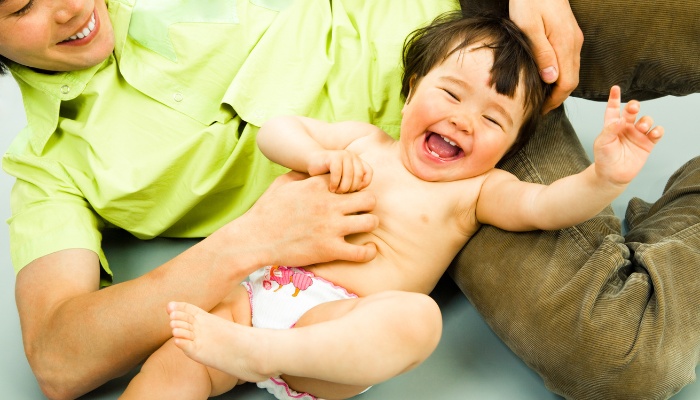Around the age of six months, babies’ neurological pathways and cognitive functions begin to develop, leading to the emergence of their true feelings of ticklishness.
At this age, babies have a stronger sense of self-awareness, which contributes to the ticklish response.
Tickling babies is more than just a playful activity—it’s a gateway to building cherished memories, forming strong bonds, and creating a positive, nurturing environment for development.
Table of Contents
Development of Ticklish Sensation in Babies
A baby’s ability to feel ticklish is connected to their neurological and cognitive development.
In the early months of life, babies primarily respond to tactile stimuli.
However, ticklishness usually starts to emerge around six months of age when various neurological pathways and cognitive functions begin to mature.
Around this age, babies also develop a stronger sense of self-awareness, which contributes to the ticklish response.
When they realize that the tickling sensation is caused by someone else, they start to find it amusing and laugh in response.
What Expert Have To Say
The University of Washington explains:
“Long before babies acquire spoken language, touch is a crucial channel of communication between caregivers and babies.”
Parenting Science builds upon this idea:
“Newborns notice how we touch them — and they get stressed when we do it the wrong way.
And babies can also get stressed when we’re too pushy — when we ignore their desire for downtime, touching and stimulating them in ways they don’t want.
So the key is to pay attention to your baby’s signals, and provide him with the sort of touching that he finds enjoyable or soothing.”
According to Dr. Trung Tristan Truong:
“A younger infant may not necessarily enjoy or dislike being tickled due to perhaps relative lack of other sensory awareness, as well as an immature social connection.”
Dr. Truong goes on to say:
“A baby who is content and playful and is being tickled by a parent who is expressing affection and making cute sounds will more likely enjoy the experience and result in laughter as the baby perceives love and caring from the parent.”
A study conducted by Ali, Spence, and Bremner found that:
“In the first months of life, infants perceive touches solipsistically, and only come to locate them in the external world after significant postnatal experience.
An early inability to appreciate the spatial interface between the body and the outside world places strong constraints on early knowledge of the physical environment, demonstrating that early spatial representations are not amodal.”
In simple terms, babies need touch to develop normally, but they lack the sensory awareness to appreciate tickles before the age of 6 months.
Reactions to Tickles in Babies
The reactions to tickles in babies are almost universally positive.
Laughter, as a response to tickling, is an essential part of a baby’s emotional development.
It fosters a sense of trust and security, promoting a strong emotional bond between the baby and the caregiver.
Moreover, laughter is known to release endorphins, the “feel-good” chemicals, which further reinforce the positive association with tickling.

Do Babies Enjoy Being Tickled?
The enjoyment of being tickled can vary from one baby to another.
Some babies may find tickling to be a delightful and amusing experience, responding with laughter and smiles.
For them, tickling can be a playful and bonding activity, fostering a positive emotional connection with their caregivers.
However, it’s essential to recognize that not all babies enjoy being tickled. Just like adults, babies have individual preferences and sensitivities.
Some babies may be more sensitive to touch or may not find tickling pleasant at all.
In such cases, they might react with discomfort, fussiness, or even crying when tickled.
The key to understanding whether a baby enjoys being tickled lies in observing their reactions and cues.
If a baby seems to respond positively with laughter, smiles, and a playful demeanor, it indicates they may enjoy tickling.
On the other hand, if a baby appears uncomfortable, tense, or tries to move away from the tickling touch, it’s crucial to respect their boundaries and avoid continuing the activity.
It’s essential for caregivers to be attentive to the baby’s signals and adjust their interactions accordingly.
If a baby does not seem to enjoy tickling, there are numerous other ways to engage and bond with them, such as gentle play, singing, talking, or simply cuddling.
Another contributing factor is the element of surprise.
Tickling often involves unexpected touches, which triggers the body’s defense mechanism, causing laughter as a response.
This reflexive laughter is an evolutionary adaptation and serves as a form of social bonding between caregivers and infants.
Why Some Babies Do Not Like Being Tickled
Some babies may not like being tickled due to their individual sensitivity to touch.
Tickling can be overwhelming or uncomfortable for them, causing distress or anxiety.
Additionally, babies may not yet have the cognitive ability to understand the playful intent behind tickling, perceiving it as a strange or confusing sensation.
It’s crucial for caregivers to respect a baby’s boundaries and cues, avoiding tickling if it elicits negative reactions.
Instead, they can focus on other forms of gentle play and bonding that the baby finds enjoyable and comforting.
One of my twins adores tickles, but the other one doesn’t care too much for tickle time, and I respect that.
Each baby’s preferences and comfort levels are unique and should be honored accordingly.
The Science Behind Ticklishness
Tickling is an intriguing sensory experience resulting from a complex interplay between our brains and bodies.
It involves a combination of physical sensations and emotional responses.
Basically, whenever you are tickled, it triggers a chain reaction from your brain to your nerve endings.
First, your brain recognizes the touch stimuli and determines if it is a “good or bad” feeling in order to elicit the correct response.
Then, our brain prompts us to giggle as a result of the stimuli.
However, to truly feel “tickled” there needs to be an element of surprise, which is why you can’t tickle yourself.
Factors Contributing to Ticklish Sensations
Several factors contribute to the ticklish sensations experienced by babies. One crucial aspect is the sense of touch.
Babies have highly sensitive skin due to an abundance of nerve endings.
Their skin is more responsive to gentle stimuli, making them more susceptible to tickling.
Benefits of Tickling
Tickling babies, when done appropriately and with sensitivity to the baby’s cues, can have several potential benefits:
Bonding and Social Interaction
Tickling can create a positive and joyful experience for both the baby and the caregiver, fostering a stronger emotional bond.
Tickling provides an opportunity for playful interactions, eye contact, and shared laughter, all of which contribute to building a secure attachment between the baby and their caregiver.
Language Development
During tickling sessions, caregivers often engage in playful verbal interactions with the baby, using funny sounds, words, or phrases.
This helps in promoting language development as the baby listens to new sounds and begins to associate words with playful and happy experiences.
Motor Skills Development
Tickling often involves gentle movements, such as wiggling fingers or toes.
This can encourage the baby to track moving objects and develop their hand-eye coordination.
As they grow older, tickling can also motivate babies to roll, crawl, or move their bodies in response to playful stimuli.
Sensory Stimulation
Tickling provides babies with tactile and proprioceptive sensory input, which can be beneficial for their overall sensory development.
It allows them to explore and become familiar with their bodies, enhancing their body awareness.
Emotional Regulation
As babies laugh during tickling, their bodies release endorphins, which are natural feel-good chemicals.
This can help in promoting a positive emotional state and contribute to emotional regulation.
Stress Relief
In some cases, gentle tickling can help alleviate mild stress or tension in babies.
The playful and affectionate touch can provide comfort and reassurance, making them feel secure and loved.
Parts of the Body That Elicit Ticklish Responses
Babies, like adults, have specific areas on their bodies that are more likely to elicit ticklish responses.
These commonly include the soles of the feet, underarms, neck, and belly.
However, it’s essential to recognize that each baby is unique, and their ticklish spots may vary.
Some babies may be more ticklish on their thighs or behind their ears, while others may find their feet or behind their knees the most ticklish.
Safe & Appropriate Ways To Tickle Babies
Tickling can be a delightful way to bond with babies, but it’s crucial to do so in a safe and appropriate manner. Here are some tips:
- Gentle Touch: Always use a gentle touch when tickling babies. Their skin is delicate, and rough handling may lead to discomfort.
- Watch for Cues: Pay attention to the baby’s reactions. If they seem uncomfortable or distressed, stop immediately.
- Respect Boundaries: Some babies may not enjoy tickling, and that’s okay. Respect their boundaries and find other ways to engage and play with them.
- Mind the Timing: Avoid tickling during feeding or when the baby is tired or cranky. Choose moments when they are alert and in a playful mood.
- Include Other Stimuli: Combine tickling with other forms of play, such as peek-a-boo or gentle games, to create a varied and enjoyable experience.
Other Ways To Make a Baby Laugh
Always be attentive to your baby’s cues and ensure that the interactions are gentle, age-appropriate, and, most importantly, enjoyable for your baby.
Every baby is unique, so pay attention to what specifically brings joy and laughter to your child. Try a few of these ideas to see what works:
- Funny Faces: Babies are often amused by exaggerated facial expressions. Make silly faces, widen your eyes, stick out your tongue, or puff up your cheeks. This visual stimulation can be quite entertaining for them.
- Peek-a-Boo: Babies love the element of surprise. Play peek-a-boo by covering your face with your hands or a cloth and then revealing it with a big smile. The anticipation and reveal can bring on bouts of giggles.
- Silly Sounds: Use your mouth to create funny sounds such as raspberries or clicks. Babies are often fascinated by different sounds, especially when they come from a familiar and friendly face.
- Play with Toys: Use colorful and interesting toys to engage the baby. Toys that make noise or have contrasting colors can capture their attention and induce laughter.
- Gentle Tossing in the Air: Lift the baby gently into the air and bring them back down with a soft bounce. Always ensure the baby feels secure and safe during this activity.
- Dance and Movement: Move your body in a playful and rhythmic way. Babies may find the motion amusing, and dancing together can be a fun bonding activity.
- Funny Voices: Experiment with different tones and pitches in your voice. Babies are often captivated by the variety of sounds you can produce, and making silly voices can be entertaining for them.
- Puppet Play: Use hand puppets or soft toys to create a little puppet show. Move the puppets around, make them “talk,” and interact with the baby.
- Mirror Play: Babies are often fascinated by their own reflection. Sit in front of a mirror with the baby and make funny faces or play peek-a-boo using the mirror.
- Blowing Bubbles: Babies may find the gentle floating motion of bubbles amusing. Blow bubbles and watch their reactions as they try to catch or follow them.
Charlynn is an educator and mom to fraternal boy/girl twins. She loves learning through the experiences she has with her littles and using her knowledge to help other moms as they embark on the journey of motherhood.

